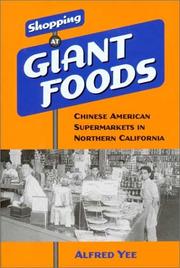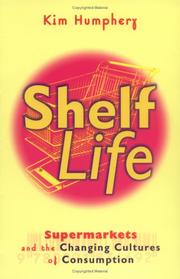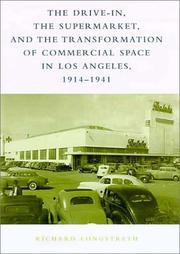| Listing 1 - 10 of 13 | << page >> |
Sort by
|
Book
ISBN: 3030746720 3030746712 Year: 2021 Publisher: Cham, Switzerland : Palgrave Pivot,
Abstract | Keywords | Export | Availability | Bookmark
 Loading...
Loading...Choose an application
- Reference Manager
- EndNote
- RefWorks (Direct export to RefWorks)
Supermarkets --- Employees. --- Super markets --- Supermarts --- Grocery trade

ISBN: 0295983043 0295802286 9780295802282 9780295983042 0295992948 9780295992945 Year: 2003 Publisher: Seattle University of Washington Press
Abstract | Keywords | Export | Availability | Bookmark
 Loading...
Loading...Choose an application
- Reference Manager
- EndNote
- RefWorks (Direct export to RefWorks)
Chinese Americans --- Supermarkets --- Super markets --- Supermarts --- Grocery trade --- Chinese --- Ethnology
Periodical
Abstract | Keywords | Export | Availability | Bookmark
 Loading...
Loading...Choose an application
- Reference Manager
- EndNote
- RefWorks (Direct export to RefWorks)
"Profitable facts, trends, ideas, products for the grocery industry."
Grocery trade --- Supermarkets --- Grocery trade. --- Supermarkets. --- Super markets --- Supermarts --- United States. --- Distribution strategy --- Business, Economy and Management --- Business Management --- Economics --- Finance --- Marketing and Sales --- Trade and Commerce

ISBN: 1281747181 9786611747183 9264028889 9264028870 Year: 2006 Publisher: Paris : OECD,
Abstract | Keywords | Export | Availability | Bookmark
 Loading...
Loading...Choose an application
- Reference Manager
- EndNote
- RefWorks (Direct export to RefWorks)
This volume examines developments in the food economy, focusing on the economic impacts of increasing retailer concentration on consumers, processors and farmers. The document estimates retail market power and assesses price transmission in the beef, pork and poultry supply chains of Canada, the Czech Republic, Japan and the Netherlands. In addition, farm marketing strategies are examined in three case studies: retail versus other labelling in the Belgian pork and beef supply chains; producer organisation in Dutch horticulture; and contract rearing in livestock production in the EU.
Animal culture. --- Animal industry -- Environmental aspects. --- Meat industry and trade. --- Supermarkets. --- Sustainable agriculture. --- Meat industry and trade --- Supermarkets --- Business & Economics --- Industries --- Super markets --- Supermarts --- Meat consumption --- Packing industry --- Grocery trade --- Food industry and trade
Book
ISBN: 9780807833278 9780807859766 Year: 2010 Publisher: Chapel Hill University of North Carolina press
Abstract | Keywords | Export | Availability | Bookmark
 Loading...
Loading...Choose an application
- Reference Manager
- EndNote
- RefWorks (Direct export to RefWorks)
Grocery shopping --- Grocery trade --- Supermarkets --- Women consumers --- Women as consumers --- Consumers --- Super markets --- Supermarts --- Grocery industry --- Grocery stores --- Food industry and trade --- Food --- Food buying --- Groceries --- Marketing (Home economics) --- Supermarket shopping --- Home economics --- Shopping --- Social aspects --- History --- Purchasing

ISBN: 0521623162 0521626307 Year: 1998 Publisher: Cambridge Cambridge University press
Abstract | Keywords | Export | Availability | Bookmark
 Loading...
Loading...Choose an application
- Reference Manager
- EndNote
- RefWorks (Direct export to RefWorks)
Supermarkets --- Grocery trade --- Retail trade --- Consumption (Economics) --- Social aspects --- #SBIB:011.AANKOOP --- #SBIB:309H2812 --- Super markets --- Supermarts --- Retail industry --- Retailing --- Commerce --- Marketing --- Shopping centers --- Wholesale trade --- Grocery industry --- Grocery stores --- Food industry and trade --- Consumer demand --- Consumer spending --- Consumerism --- Spending, Consumer --- Demand (Economic theory) --- Marketing, consumentengedrag, consumentisme
Book
ISBN: 1920597301 9781920597306 192059728X 9781920597283 Year: 2017 Publisher: Oxford Southern African Migration Programme (SAMP)
Abstract | Keywords | Export | Availability | Bookmark
 Loading...
Loading...Choose an application
- Reference Manager
- EndNote
- RefWorks (Direct export to RefWorks)
The surprisingly high rate of supermarket patronage in low-income areas of Windhoek, Namibia's capital and largest city, is at odds with conventional wisdom that supermarkets in African cities are primarily patronized by middle and high-income residents and therefore target their neighbourhoods. What is happening in Namibia and other Southern African countries that make supermarkets so much more accessible to the urban poor? What are they buying at supermarkets and how frequently do they shop there? Further, what is the impact of supermarket expansion on informal food vendors? This report, which presents the findings from the South African Supermarkets in Growing African Cities project research in 2016-2017 in Windhoek, looks at the evidence and tries to answer these questions and others. The research and policy debate on the relationship between the supermarket revolution and food security is also discussed. Here, the issues include whether supermarket supply chains and procurement practices mitigate rural food insecurity through providing new market opportunities for smallholder farmers; the impact of supermarkets on the food security and consumption patterns of residents of African cities; and the relationship between supermarket expansion and governance of the food system, particularly at the local level.
Urban poor --- Low-income consumers --- Food security --- Supermarkets --- Grocery shopping --- Food --- Food buying --- Groceries --- Marketing (Home economics) --- Supermarket shopping --- Home economics --- Shopping --- Super markets --- Supermarts --- Grocery trade --- Food deserts --- Food insecurity --- Insecurity, Food --- Security, Food --- Human security --- Food supply --- Disadvantaged consumers --- Poor as consumers --- Consumers --- City dwellers --- Poor --- Purchasing --- E-books
Multi
ISBN: 9172461926 Year: 2001 Publisher: Göteborg : BAS,
Abstract | Keywords | Export | Availability | Bookmark
 Loading...
Loading...Choose an application
- Reference Manager
- EndNote
- RefWorks (Direct export to RefWorks)
Theses --- Industrial management --- Retail trade --- Social responsibility of business --- Supermarkets --- Environmental aspects --- Super markets --- Supermarts --- Grocery trade --- Business --- Corporate accountability --- Corporate responsibility --- Corporate social responsibility --- Corporations --- CSR (Corporate social responsibility) --- Industries --- Social responsibility, Corporate --- Social responsibility of industry --- Business ethics --- Issues management --- Retail industry --- Retailing --- Commerce --- Marketing --- Shopping centers --- Wholesale trade --- Business administration --- Business enterprises --- Business management --- Corporate management --- Industrial administration --- Management, Industrial --- Rationalization of industry --- Scientific management --- Management --- Industrial organization --- Social responsibility --- Social aspects

ISBN: 0262122146 0262621428 9780262122146 9780262621427 0262278545 1423725239 9780262278546 9781423725237 Year: 1999 Publisher: Cambridge, Mass. MIT Press
Abstract | Keywords | Export | Availability | Bookmark
 Loading...
Loading...Choose an application
- Reference Manager
- EndNote
- RefWorks (Direct export to RefWorks)
Longstreth explores the early development of two kinds of retail space that have become ubiquitous in the United States in the second half of the twentieth century. Richard Longstreth is one of the few historians to focus on ordinary commercial buildings—buildings usually associated with commercial builders and real estate developers rather than architects and thus generally overlooked by historians of "high" architecture. Here Longstreth explores the early development of two kinds of retail space that have become ubiquitous in the United States in the second half of the twentieth century. One, external, is devoted to the circulation and parking of automobiles on retail premises. Longstreth analyzes the origins of this development in the 1910s and 1920s, with the super service station and then the drive-in market. The other type of space, internal, was introduced soon thereafter with the single-story supermarket. The most innovative aspect of the supermarket was how its interior was designed for high-volume turnover of a large selection of goods with a minimum of staff assistance. Longstreth focuses on Los Angeles, the principal center for the development of both kinds of space, during the period from the mid-1910s to the early 1940s. This richly illustrated study integrates architectural, cultural, economic, and urban factors to describe the evolution of retailing and how it has affected the urban landscape.
Commercial buildings
---
Drive-in facilities
---
Einzelhandel.
---
Geschichte
---
Los Angeles

ISBN: 0253144957 Year: 1979 Publisher: Bloomington Indiana university press
Abstract | Keywords | Export | Availability | Bookmark
 Loading...
Loading...Choose an application
- Reference Manager
- EndNote
- RefWorks (Direct export to RefWorks)
Food industry and trade --- -Music --- -Performance practice (Music) --- Supermarkets --- Musical performance practice --- Performing practice (Music) --- Art music --- Art music, Western --- Classical music --- Musical compositions --- Musical works --- Serious music --- Western art music --- Western music (Western countries) --- Agricultural processing industries --- Processed foods --- Food preparation --- Food preparation industry --- Food processing --- Food processing industry --- Food trade --- Grocery trade --- Super markets --- Supermarts --- History and criticism --- -Sources --- Performance --- -Musical performance practice --- Music --- Food --- Food technology --- Processing --- 78.50 --- -Super markets --- -History and criticism
| Listing 1 - 10 of 13 | << page >> |
Sort by
|

 Search
Search Feedback
Feedback About UniCat
About UniCat  Help
Help News
News